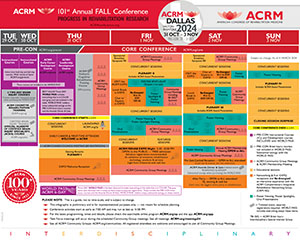Caregiver Needs
Health Services Research
Health Information Needs of Individuals with Traumatic Brain Injury and Their Families and Caregivers
Saturday, November 2, 2024
9:30 AM - 9:45 AM
Location: Station 11: ROOM: POSTERLAND / Trinity Poster / Exhibit Hall REGION: Tower Lobby Level >>>

Xinsheng Cindy Cai, PhD (she/her/hers)
Principal Researcher
American Institutes for Research
arlington, Virginia, United States
Presenting Author(s)
Research Objectives: Moderate and severe traumatic brain injury (TBI) can be a chronic condition. Like cancer and diabetes, it requires long-term management to provide post-acute and rehabilitation care throughout life (Heiden & Caldwell, 2019). Patient and caregiver health education and materials are key components of chronic disease management (Hart et al., 2018; Wallace et al., 2009). Research showed that patient and caregiver health education materials and programs can increase patients’ knowledge, self-advocacy, and health behaviors leading to improved health outcomes and reduced health care costs (e.g., Marmet et al., 2020; Stenberg et al., 2018; Unsworth, Mathias, Dorstyn, & Koblar, 2020). The objective of the study is to understand the health information needs of individuals living with TBI and their families to help guide the development and delivery of patient and caregiver education and resources.
Design: Online survey
Setting: Community settings.
Participants: Sample includes 97 individuals with traumatic brain injury and 24 family members and caregivers who took the online survey.
Interventions: No intervention is involved.
Main Outcome Measures: The survey collected data on the health information topics that people with TBI, their families and caregivers would like to learn more about, their preferred formats and learning styles, and channels they want to receive health information.
Results: Individuals with TBI and their families and caregivers need information on a wide range of health and wellness topics. About 37% participants prefer reading health information on computers or mobile devices, 22% prefer reading the information from a printed piece of paper, and 34% prefer audio and video format. Participants reported ways that they most enjoy learning new health information, which are through seeing or hearing just facts and figures (15%), seeing or hearing full explanations (20%), seeing or hearing stories and real-life examples (21%), hands-on experiences (19%), and a combination of facts and stories (25%). When asked about their preferred channels for receiving health information, more participants mentioned websites, emails including e-newsletters, social media, and doctors and nurses than other channels.
Conclusions: The study showed that people with TBI and their families and caregivers have diverse learning styles and receiving health information from various channels. To maximize the impact of health education, it is important for healthcare professionals to understand the health information needs of patients and families and tailor the health education programs and resources to meet their needs.
Author(s) Disclosures: There is no conflict of interest. The study is funded by the National Institute on Disability, Independent Living, and Rehabilitation Research under grant 90DPKT0009.
Design: Online survey
Setting: Community settings.
Participants: Sample includes 97 individuals with traumatic brain injury and 24 family members and caregivers who took the online survey.
Interventions: No intervention is involved.
Main Outcome Measures: The survey collected data on the health information topics that people with TBI, their families and caregivers would like to learn more about, their preferred formats and learning styles, and channels they want to receive health information.
Results: Individuals with TBI and their families and caregivers need information on a wide range of health and wellness topics. About 37% participants prefer reading health information on computers or mobile devices, 22% prefer reading the information from a printed piece of paper, and 34% prefer audio and video format. Participants reported ways that they most enjoy learning new health information, which are through seeing or hearing just facts and figures (15%), seeing or hearing full explanations (20%), seeing or hearing stories and real-life examples (21%), hands-on experiences (19%), and a combination of facts and stories (25%). When asked about their preferred channels for receiving health information, more participants mentioned websites, emails including e-newsletters, social media, and doctors and nurses than other channels.
Conclusions: The study showed that people with TBI and their families and caregivers have diverse learning styles and receiving health information from various channels. To maximize the impact of health education, it is important for healthcare professionals to understand the health information needs of patients and families and tailor the health education programs and resources to meet their needs.
Author(s) Disclosures: There is no conflict of interest. The study is funded by the National Institute on Disability, Independent Living, and Rehabilitation Research under grant 90DPKT0009.
Learning Objectives:
- Learn the health information needs of people with traumatic brain injury and their family members.
- Learn how people with traumatic brain injury and family members receive health information.
- Understand the diverse learning styles of individuals with traumatic brain injuries and their family members to better serve them.

.jpg)
.jpg)
.jpg)
